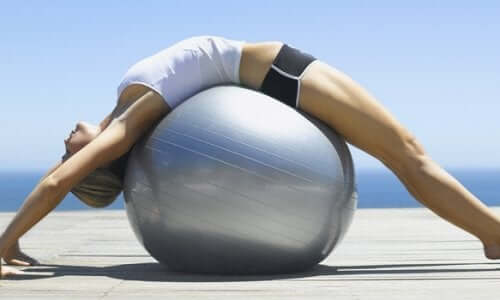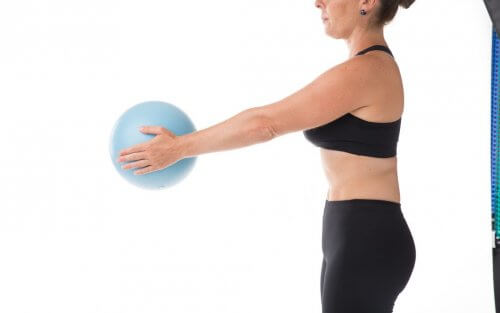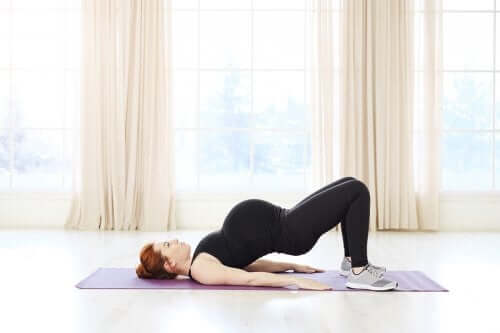Pilates During Pregnancy: Is it a Good Idea?

Exercise during pregnancy benefits both mom and baby. In general, doctors recommend that pregnant women stick to low-impact physical activity, such as swimming, walking or yoga. An option that attracts mothers-to-be is pilates.
But is it a healthy form of exercise for pregnant women?
Pilates During Pregnancy: Is it a Good Idea?
Today, we’d like to answer some of the questions you may have about Pilates and whether or not it’s healthy for your pregnancy.
What’s Pilates?

Joseph Hubertus Pilates was the creator of this physical exercise that bears his name. Pilates was designed to work the body and mind at the same time. The goal is to promote concentration, control, and breathing, among other things.
You can do Pilates on the ground or with exercise equipment. Your body works to increase strength, improve flexibility and agility. On an emotional level, it helps increase self-esteem and connect with yourself.
However, is it possible to do Pilates during pregnancy?
The answer varies depending on the physical condition of every pregnant woman.
Each person and each pregnancy are different. Your obstetrician should help you determine whether you can do pilates or not.
The practice of Pilates can help strengthen a mother’s body. However, always consult with your doctor before you begin a new exercise routine.
How to Do Pilates During Pregnancy

Suppose you’ve gone to the doctor and they evaluated your physical condition. They concluded that it’s safe for you to do Pilates.
If so, how many times a week should you do it? Could you keep up with all the exercise load?
Recommendations vary from one specialist to another. Here are some observations on this matter from the Journal of Yoga and Physical Therapy:
- You can do Pilates from the moment you get pregnant all the way to the day you give birth. However, you should always do so under medical supervision.
- Do it between two and three times per week.
- During the first trimester, your exercises shouldn’t exceed 20 minutes. You may later extend them up to 45-60 minutes per session when your pregnancy is more advanced.
- When doing pilates, it’s important to focus on doing the exercises correctly.
Discover: High Blood Pressure during Pregnancy: Symptoms and Treatments
The Benefits of Pilates for Pregnant Women

Pilates during pregnancy can be highly beneficial for both you and your baby not only physically, but also emotionally.
Among its main benefits, Pilates helps:
- Decrease of fear of giving birth: Pilates breathing exercises can help women to better withstand their birthing contractions.
- Improve your future dilation due to flexible work.
- Strengthen your pelvic floor.
- Improve your flexibility and coordination.
- You learn breathing and self-control practice that will help a lot during labor.
- Prevent varicose veins, hemorrhoids, and backaches.
- Improve your self-esteem.
- Tone your body.
- Practice relaxation.
- Improve your sleep and prevent insomnia.
You may be interested: All About Preeclampsia, a Complication of Pregnancy
When is Pilates not Recommended During Pregnancy?

As we have said before, your doctor should advise you on whether or not you can do Pilates. In general, this exercise is not recommended in certain cases such as:
- Pregnant woman with high blood pressure.
- Premature rupture of membranes.
- When there’s a delay in intrauterine growth.
- In women with preeclampsia.
- If the mother-to-be has a high-risk pregnancy.
On this note, try to attend Pilates classes designed for pregnant women, as some exercises in other types of Pilates are contraindicated during pregnancy. These include supine exercises (where the abdominal rectum contracts), those performed upside down, and deep stretches.
Pilates during pregnancy can bring many benefits to you and your baby. However, you should check with your doctor before enrolling in any Pilates programs.
Remember that you shouldn’t make any change in your habits during pregnancy without consulting your obstetrician. Your health and your child’s come first!
All cited sources were thoroughly reviewed by our team to ensure their quality, reliability, currency, and validity. The bibliography of this article was considered reliable and of academic or scientific accuracy.
- Dilek S G. Pregnancy Pilates and Benefits of Pregnancy Pilates during Childbirth. J Yoga & Physio. 2018; 5(1): 555652. DOI:10.19080/JYP.2018.05.555652.002
King M, Green Y (2002) Pilates workbook for pregnancy. Octopus Publishing Group, Canada. - NCBI. (2009). Effects of natural childbirth preparation versus standard antenatal education on epidural rates, experience of childbirth and parental stress in mothers and fathers: a randomised controlled multicentre trial. https://www.ncbi.nlm.nih.gov/pubmed/19538406
- Balogh, A. (2005). Pilates and pregnancy. RCM Midwives : The Official Journal of the Royal College of Midwives, 8(5), 220—222. Retrieved from http://europepmc.org/abstract/MED/15960329
This text is provided for informational purposes only and does not replace consultation with a professional. If in doubt, consult your specialist.








